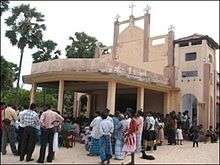St. Philip Neri Church shelling
| St. Philip Neri Church shelling | |
|---|---|
 The Roman Catholic church which provided shelter to the refugees after the Allaipiddy massacre and during the subsequent shelling | |
| Location | Allaipiddy, Jaffna district, Sri Lanka |
| Date | August 13, 2006 (+6 GMT) |
| Target | Sri Lankan Tamil refugees |
Attack type | Artillery fire |
| Weapons | Artillery shells |
| Deaths | 15 |
| Perpetrators | LTTE (Government claim) |
The St. Philip Neri Church shelling occurred when St. Philip Neri Church in Allaipiddy village, off the coast of Sri Lanka's Jaffna Peninsula, was shelled on August 13, 2006, allegedly by the Sri Lankan Army.[1] The attack killed at least 15 people and injured as many as 54 others.[2]
Background
As tensions increased between the rebel Liberation Tigers of Tamil Eelam (LTTE) and the Sri Lankan Army, small clashes took place near Allaipiddy. It is believed that the LTTE was planning to overrun Jaffna.[3] Hundreds of civilians took shelter in St. Philip Neri Church because of the fighting and to avoid shelling.[4]
Incident
In the morning of August 12, 2006, LTTE cadres landed near Allaipiddy, prompting government forces to withdraw to the nearby Navy base.[3][5] The Sri Lankan Army then commenced shelling LTTE positions, continuing through the night. According to a local human rights organization, the University Teachers for Human Rights (UTHR), security forces did not know the strength of LTTE forces in the area and "let loose their shells and MBRLs not caring an iota for the civilians".[3]
On August 13, 2006, at 04:30, an artillery shell fell on the church, killing at least 15 people and injuring up to 54.[2][3][4] The wounded were taken to Jaffna for treatment by a priest, Father Thiruchelvam Nihal Jim Brown,[3] who subsequently relocated 300 families from Allaipiddy to St. Mary's Church in Kayts. He disappeared on August 20, a week after the shelling.[4][6]
Responsibility
The Army denied responsibility for the shelling of the church and suggested that the LTTE was to blame. However, according to the former[6] parish priest of Allaipiddy, most people believe that the church was hit by fire from government forces.[5] The UTHR reported that survivors claimed that the shelling came from a military base in Palaly.[3] A pro-LTTE website repeated this claim.[5]
References
- ↑ Akkara, Anto (2007-06-21). "Peace deferred". Council for World Mission. Archived from the original on 2007-08-18. Retrieved 2007-08-21.
- 1 2 "The Killing Match". Amnesty International Magazine. Amnesty International. 2006. Retrieved 2007-08-21.
- 1 2 3 4 5 6 "From Welikade to Mutur and Pottuvil: A Generation of Moral Denudation and the Rise of Heroes with Feet of Clay". University Teachers for Human Rights. 2007-05-31. Retrieved 2007-08-19.
- 1 2 3 "Sri Lanka church shelled in government attack on rebels". Catholic Online. 2006-08-14. Retrieved 2007-08-16.
- 1 2 3 "Hell in the north: church and children's home destroyed". AsiaNews.it. 2006-08-14. Retrieved 2007-08-18.
- 1 2 "Sri Lankan priest disappears as civilian toll mounts". St Francis Xavier's Church. Retrieved 2007-08-19.